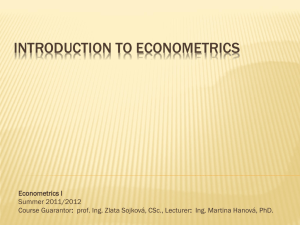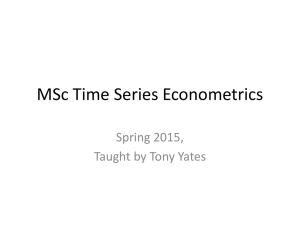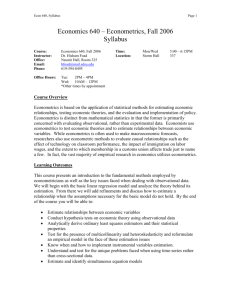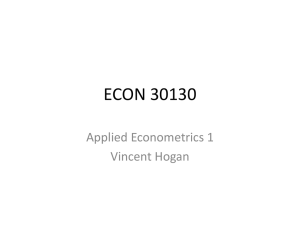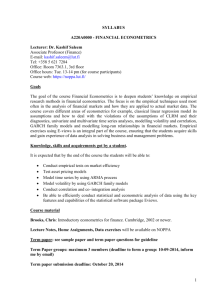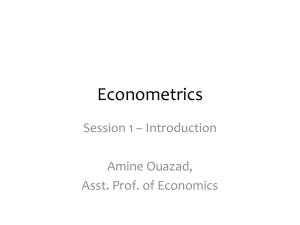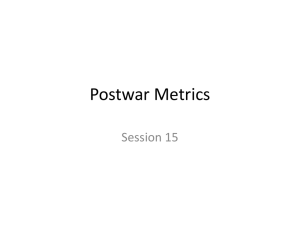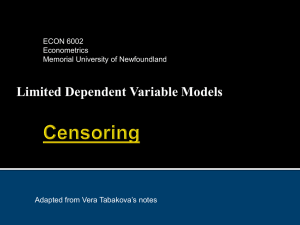Thirlwall
advertisement
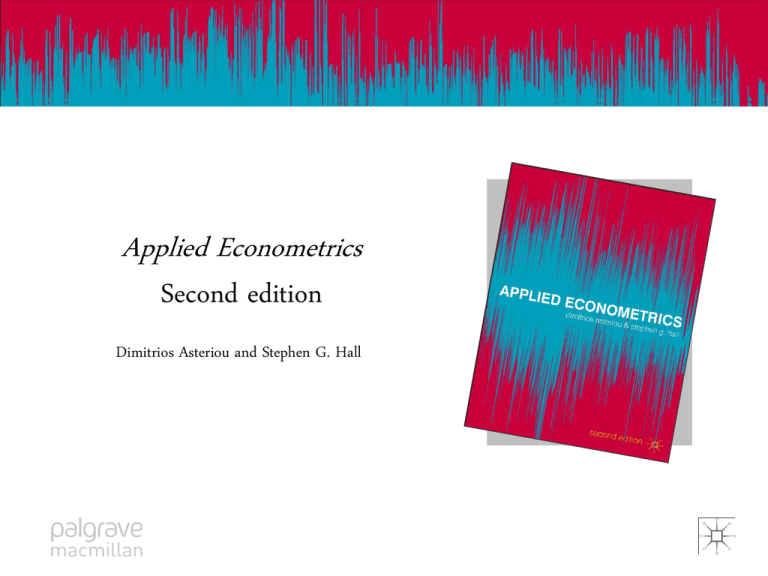
Applied Econometrics Applied Econometrics Second edition Dimitrios Asteriou and Stephen G. Hall Applied Econometrics Applied Econometrics SIMPLE REGRESSION 1. Introduction to the Classical Linear Regression Model 2. The OLS Method of Estimation 3. The Overall Goodness of Fit 4. Hypothesis Testing 5. How to Estimate a Simple Regression in Eviews 6. Applications and Examples Applied Econometrics • • • • Learning Objectives Compute the equation of a simple regression line from a sample of data, and interpret the slope and intercept of the equation. A full understanding of the simple OLS method of estimation and discussion of the properties of estimated coefficients. Computation of a standard error of the estimate and interpretation of its meaning and its use in Hypothesis Testing. Understanding and interpretation of the R2 Applied Econometrics Introduction • Regression analysis is the process of constructing a mathematical model or function that can be used to predict or determine one variable by another variable. • Key issue here is direction of causation of the two variables, or which variable depends on the other. • Therefore we have two cases of variables dependent variables (usually denoted by Y) independent or explanatory (usually denoted by X) Applied Econometrics The Scatter Plot X 300 250 200 150 X 100 50 0 0 20 40 60 80 100 120 140 160 180 Applied Econometrics Four Ways of Fitting a Line in the Data • By eye • Connecting the first with the last observation • Take the average of the first two and the average of the two last and connect • Apply Ordinary Least Squares Applied Econometrics Regression Models Deterministic Regression Model: Y=0+1X Probabilistic Regression Model: Y=0+1X+u 0 and 1 are population parameters 0 and 1 are estimated by sample statistics b0 and b1 Applied Econometrics Equation of the Regression Line Yˆ b 0 b1 X where : b 0 = the sample intercept b1 = the sample slope Yˆ = the predicted value of Y Applied Econometrics Slope and Intercept of the Regression Line b 1 X X Y Y X X b 0 Y 2 b 1 XY nXY X n X X 2 Y n b 2 XY X 1 n X X Y n 2 X n 2 Applied Econometrics Least Squares Analysis S S XY X S S XX X X b b 0 1 X Y Y 2 X XY 2 S S XY S S XX Y b1 X Y n b1 n X X Y n X n 2 Applied Econometrics Example: The Keynesian Consumption Function Applied Econometrics Example: The Keynesian Consumption Function C2=B2*A2 D2=B2*B2 A22=SUM(A2:A21) B22=SUM(B2:B21) and so on! ExcelEconometrics Calculations Applied b0=(C22-(A22*B22)/20)/(D22-((B22ˆ2)/20))=0.601888903 b1=AVERAGE(A2:A21)-G2*AVERAGE(B2:B21)=15.116408 Applied Econometrics Excel Calculations (the easy way!) • Step 1: go to the menu Tools/Data Analysis and choose the command regression. • Step 2: We are then asked to specify the Input Range, Output Range, and a choice of including or not labels in the first row. • Step 3: The Input Range is the columns that contain the data for Y and X (i.e. we enter ‘$A$1:$B$21’ or simply select this area using the mouse). • Step 4: The Output Range can be either a different sheet (not recommended) or any empty cell in the current sheet (i.e. we might specify cell F5). • Step 5: Since we have chosen the labels in our selection we tick the box. • Step 6: By clicking <OK> we obtain the display shown in Table 4.4. Applied Econometrics Excel Results Applied Econometrics: A Modern Approach using Eviews and 15 Applied Econometrics The Regression Line X 300 250 200 150 X Linear (X) 100 50 0 0 20 40 60 80 100 120 140 160 180 Applied Econometrics The Coefficient of Determination The proportion of variability of the dependent variable accounted for or explained by the independent variable in a regression model. It is called R2 and it takes values from 0-1. 17 Applied Econometrics Hypothesis Tests for the Slope of the Regression Model H 0: 0 t 1 H 1: 0 1 H 0: 0 1 H 1: 0 w h ere : S S b e b 1 S S b e S S XX SSE n2 1 H 0: 0 1 H 1: 0 1 S S XX 1 1 X 2 X 2 n th e h yp o th esiz ed slo p e df n 2 Applied Econometrics Regression in Eviews (1) (1) Step 1 Open EViews. Step 2 Choose File/New/Workfile in order to create a new file. Step 3 Choose Undated or Irregular and specify the number of observations (in this case 20). A new window appears which automatically contains a constant (c) and a residual (resid) series. Applied Econometrics Regression in EViews (2) Step 4 In the command line type: genr x=0 (press enter) genr y=0 (press enter) which creates two new series named x and y that contain zeros for every observation. Open x and y as a group by selecting them and double clicking with the mouse. Step 5 Either type the data in EViews or copy/paste the data from Excel®. To edit the series press the edit +/− button. After finishing with editing the series press the edit +/− button again to lock or secure the data.
